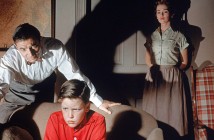Editor’s Notes: Ant-Man opens in wide theatrical release today, July 17th.
Just because a superhero once, long ago, had his own comic book – or better yet, occasionally co-starred as a supporting player in comic-book publisher’s long-running, popular team-up – doesn’t mean he or she (but until now, it hasn’t been a “she”), deserves and/or merits his or her own standalone film. In the case of Ant-Man, the insect-sized superhero with the power to mind control lower life forms, Kevin Feige, Marvel’s go-to executives for everything cinematic, thought otherwise. After a protracted development period lasting the better part of a decade, two so-called “phases” (1 and 2), and the abrupt departure of writer-director Edgar Wright (The World’s End, Scott Pilgrim vs. the World, Hot Fuzz, Shaun of the Dead) last summer only weeks before the official start of production, Ant-Man reaches the screen in sadly diluted form, formulaic, sanitized, homogenized corporate product. But as the saying goes, one filmmaker’s departure is another filmmaker’s opportunity. Enter replacement director Peyton Reed (Down With Love).
Ant-Man reaches the screen in sadly diluted form, formulaic, sanitized, homogenized corporate product.
Ant-Man isn’t just small in stature, but the stakes at the center of the film that bears his name are just as small, if not smaller: Nothing more - and it should be added, a whole lot less - than revolutionizing military combat, the weaponization of the Ant-Man concept into an exo-suit capable of rapidly shrinking the lucky owner/user. Why that would be much of an advantage after the first battle or encounter (effective counter-measures could be generated easily) isn’t something Ant-Man (the film, not the character) wants the audience to consider even momentarily. One superfluous scene, apparently added so Marvel could explicitly connect Ant-Man to the larger, shared superhero universe of the Avengers (not counting equally unnecessary lines of dialogue meant to function similarly), features a second-tier Avenger with enhanced goggles detecting Anti-Man within seconds. Still, moviegoers are expected to cast all logical considerations aside and simply accept Ant-Man as Marvel’s newest, indispensable superhero. Not so fast, Marvel’s Powers-That-Be. Not so fast.
What Ant-Man doesn’t have in original plot points, meaningful stakes, or better developed, non-clichéd characters.
With major plot points liberally borrowed from the Iron Man series, up to and including, but not limited to, yet another megalomaniacal corporate CEO (an all too common affliction within the Marvel Cinematic Universe apparently), Darren Cross (Corey Stoll), weaponized armor, political conflict between the suit’s owner/designer and the military and/or U.S. government (because private citizens, especially of the billionaire kind), almost always know best. It may be a coincidence, but when Hank Pym (Michael Douglas), the once and no longer Ant-Man and the creator/discoverer of the so-called “Pym Particle” responsible for all that shrinkage, sits in a room filled with video monitors, he’s inadvertently echoing George Clooney’s similarly inclined recluse in Brad Bird’s recent (and recently disappointing) ode to elitism and libertarianism, Tomorrowland. Add to that a disgruntled, estranged adult daughter, Hope Van Dyne (Evangeline Lilly), and father-daughter reconciliation and with it, something like redemption awaits Pym. It also awaits Scott Lang (Paul Rudd), the once and future Ant-Man, a not-so-hardened felon, only days away from a five-year bid at San Quentin (where only the hardest of hardened criminals go), and it’s all about redemption.
Lang steals the suit out of desperation, an ex-felon - in his case, a goodhearted one with whistleblowing, burglary, and Robin Hood-inspired deeds on his record - who can’t find, let alone hold down a steady job. He has an ex-wife, Maggie (Judy Greer, fresh off the Jurassic World set), who coldly turns him away from their daughter’s birthday party, said daughter, Cassie (Abby Ryder Fortson), he can’t see until he can show up with dollar bills (yo), and an bunkmate, Luis (Michael Peña), a walking, mumbling Mexican-American stereotype, who pulls him back into a life of crime: Stealing the Pym-powered exo-suit that turns Lang into Ant-Man. It’s all a ruse, though, a tryout of sorts Lang passes. It’s also prep for a bigger, far more complex heist of the other incredibly shrinking, close-to-perfection exo-suit owned and operated by Cross, a montage training sequence sadly devoid of Rocky’s theme song, and the obligatory, if woefully underdeveloped, romantic relationship/partnership with Hope. She initially wants nothing to do with Lang and everything to do with putting on the Ant-Man suit herself. Pym’s repeated refusal, however (like any patriarchal male of a certain age and disposition, he’s overprotective of his capable, competent, adult daughter), puts additional strain on their already strained relationship.
What Ant-Man doesn’t have in original plot points, meaningful stakes, or better developed, non-clichéd characters, it almost (operative word being “almost”) makes up for it via not unexpected visual gags, some clever, some not so clever, verbal humor (a generationally irrelevant joke involving The Andy Griffith Show for one), and visually inventive set pieces, a likely holdover from Wright’s involvement at the script stage and in pre-production. He’s called Ant-Man not just for his small stature, but also for his ability to control different species of ants through electronic waves of some kind or another. That will be more than enough for moviegoers who’ve been trained well over eight years and now twelve entries in the MCU. Casual fans might and should be less forgiving: The over-reliance on the Marvel formula, clunky, exposition-filled scenes, and extraneous MCU references suggests Marvel’s top-down, authoritarian style of corporate filmmaking needs a significant shake up, maybe even a subversion or two of tried-and-no-longer-true superhero conventions and tropes.
The over-reliance on the Marvel formula, clunky, exposition-filled scenes, and extraneous MCU references suggests Marvel's top-down, authoritarian style of corporate filmmaking needs a significant shake up, maybe even a subversion or two of tried-and-no-longer-true superhero conventions and tropes.




